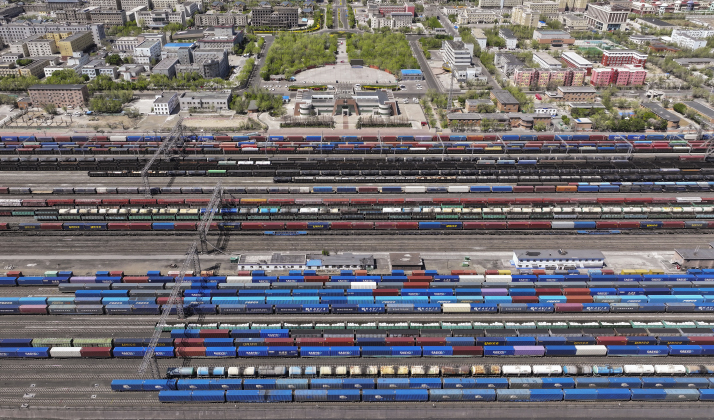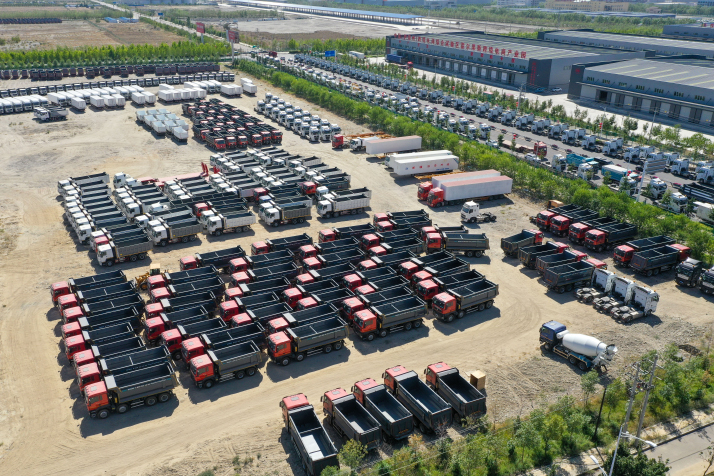| Xinjiang Today |
| Wheels of change | |
|
|
 Inbound and outbound China Railway Express freight trains at the Alashankou Station in Bortala Mongolian Autonomous Prefecture on May 25, 2024 (XINHUA)
When camel caravans traveled along the ancient Silk Road to the rhythm of jingling bells, Xinjiang in northwest China was a vital crossroads for trade and cultural exchange, connecting the East and West. Today, the whistling trains of the China Railway Express (CR Express) have replaced those caravans, transforming Xinjiang—located at the heart of the Eurasian continent and bordering eight countries—into a dynamic gateway for China's high-standard opening up. The CR Express, a flagship project under the China-proposed Belt and Road Initiative (BRI) to boost connectivity along and beyond the ancient Silk Road routes, is an international and intermodal container freight service between China and Europe via other countries participating in the initiative. The CR Express trains run on a network of cross-border railways consisting of three trunk transport corridors between China and Europe: the west, middle and east corridors. In Xinjiang, which lies on the west corridor, CR Express trains make their way to neighboring Kazakhstan and Russia through two key border ports—Alashankou (Alataw Pass) and Huoerguosi (Khorgas or Horgos), before reaching destination countries such as Belarus, Poland, Germany, Hungary, Italy and the Netherlands. Alashankou and Huoerguosi are critical gateways for westbound CR Express trains. Last year, over 16,400 CR Express train trips—more than 50 percent of the national total—were made through the two Xinjiang border crossings. They also handled 27.5 million tons of goods, accounting for nearly 70 percent of the region's total land-based import and export volume. At the same time, the rise of logistics hubs like the Urumqi International Land Port Area in regional capital Urumqi, and the China-Kazakhstan Huoerguosi International Border Cooperation Center, a joint project between the two countries to facilitate free movement of people, goods and transport, has accelerated Xinjiang's export-oriented economy, consolidating its status as a golden corridor for trade between Asia and Europe.  Domestically made vehicles at the Huoerguosi dry port on July 26, 2023 (XINHUA)
A golden key The first CR Express train was launched on March 19, 2011, departing from Chongqing Municipality to arrive in Duisburg, Germany, via Xinjiang, 16 days later. This marked the beginning of the rail service's innovative development. This year, the CR Express achieved a remarkable milestone on June 10—its 110,000th journey. After more than a decade of exploration and growth, it has evolved from a single route into an extensive network that is transporting increasing volumes of goods to international markets, establishing itself as a convenient, efficient, safe, stable and eco-friendly new mode of international transport. The trains now connect 128 Chinese cities with 229 cities in 26 European countries, and over 100 cities in 11 Asian countries, forming a network that essentially covers the entire Eurasian landmass, according to Xinhua News Agency. "Alashankou is the international trade channel (to Europe) with the shortest distance, takes the least time, and has the lowest freight cost on the Silk Road," Li Jianglin, Executive Deputy Mayor of Alashankou, told People's Daily. To enhance efficiency, Xinjiang's railway authorities have slashed import clearance time from two to three days to 16 hours, while export processing now takes just an hour, down from six. Thanks to the western route of the CR Express and the New International Land-Sea Trade Corridor, a key logistics network connecting China's western regions to the Association of Southeast Asian Nations (ASEAN) countries, Xinjiang now has trade with over 200 countries and regions. The region's economic and trade cooperation with ASEAN has deepened. The New International Land-Sea Trade Corridor, also known as the Xinjiang-Chongqing-ASEAN cross-border intermodal transport corridor, connects ASEAN with Central Asia via China. Its advantage is rail-sea intermodal transport, with Chongqing as a key hub and the Beibu Gulf Port in south China as a major port for connecting with Singapore and other ASEAN countries. The China-Laos Railway international cold-chain freight service, which facilitates the transport of perishable goods, assembles its cargo at the Urumqi International Land Port Area and heads south via Kunming in Yunnan Province. It is a convenient channel for Xinjiang's products to access ASEAN markets while attracting more ASEAN goods into Xinjiang. "Xinjiang is like a golden key—it unlocks both the Central Asian market and provides direct access to Southeast Asian markets," Jacob Lee Chor Kok, Managing Director of Malaysia's Asli Mechanical, which manufactures ventilation products, told Xinjiang Daily. New growth opportunities The reliability of CR Express trains has enabled Xinjiang's products to reach global markets faster. In 2024, the region's foreign trade surged to 435.11 billion yuan ($60.68 billion), marking a 21.8 percent year-on-year increase, according to Xinhua. Jinyi International Trade, an agricultural export enterprise born in Huoerguosi, has grown into one of the leading fruit and vegetable exporters in Central Asia in just over a decade. "The rapid development of the port in recent years has created better conditions for exporting agricultural products from Huoerguosi," Yu Chengzhong, chairman of the company, told People's Daily. "In the past, it took two or three days for fruits and vegetables to clear customs; but now, with the green channel for fast clearance, Chinese produce can reach supermarket shelves in Kazakhstan within a day." This has not only boosted the growth of export-oriented businesses but also brought new opportunities for Xinjiang's development. Inside the China-Kazakhstan Huoerguosi International Border Cooperation Center, merchants and tourists from both countries and beyond are a common sight. As China's first cross-border economic and trade zone with another country, the center has, since its launch 13 years ago, attracted nearly 30 key projects. They include star hotels, dining and entertainment facilities, commercial establishments and financial services, making the center a vital platform for trade and cultural exchanges between China and Kazakhstan. The increasing demand for cross-border logistics vehicles, international self-drive tourism, and vehicle maintenance from Central Asian countries has spurred the rise of cross-border repair services, leading to the establishment of a cross-border international auto service center in the cooperation center. As the largest land port for auto exports in China, Huoerguosi shipped 421,000 vehicles last year, up 38.6 percent year on year. "The achievements made by the cooperation center are truly astonishing," Shanghai Cooperation Organization Deputy Secretary-General Sohail Khan told People's Daily, adding that it should be explored how this successful experience can be replicated to promote similar projects in more countries. Smooth trade channels mean thriving business, especially in logistics, manufacturing, and emerging industries such as cross-border e-commerce. The Alashankou Comprehensive Bonded Zone, for example, has formed five distinctive industry clusters of over 800 enterprises with competitive edges, including imported grain processing, timber processing, export equipment manufacturing, medical materials and cross-border e-commerce.  Containers are loaded and unloaded at the Urumqi International Land Port Area on May 27, 2024 (XINHUA)
Updated services Xinjiang's local services have improved remarkably. The Urumqi International Land Port Area provides one-stop services for the trains, including loading and unloading, marshaling, inspection, and dispatch in a single location. The railway sector has strengthened coordination with customs, border inspection, cargo owners and logistics agencies, implementing projects such as a digital port infrastructure and paperless clearance system, along with express clearance and advanced transmission of manifest data, that is, electronic submission of cargo information to customs authorities before a shipment arrives at the port. The railway authorities maintain regular dialogue with Kazakhstan's railway authorities to enhance dispatch coordination and improve border crossing efficiency. In the past, goods arriving in the port area had to be unloaded, then reloaded on a secondary vehicle, leading to delays and cargo congestion. But on May 20, the inaugural multimodal transport Tianshan train, carrying 50 containers loaded with auto parts, household appliances and other goods, set off from the Urumqi assembly center without delay, offering seamless transfer and non-stop delivery. This upgraded logistics model has improved transport efficiency by 20 percent while reducing costs by 1,713 yuan ($239) per container, according to Chen Zhi, a staff at the Urumqi International Land Port Area. To develop cross-border e-commerce and leverage the advantages of the Alashankou railway border crossing and the Alashankou Comprehensive Bonded Zone, Alashankou has established a 28,000-square-meter sorting and customs clearance center. The customs clearance process prioritizes the declaration, sealing and inspection of cross-border e-commerce goods. As Xinjiang opens up wider to the world, its ports of entry are thriving and foreign trade is growing at a high rate, providing important support for the BRI, Hao Weiming, chief of Urumqi Customs, told People's Daily. Comments to mamm@cicgamericas.com |
|
||||||||||||||||||||||||||||
|